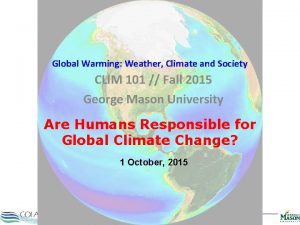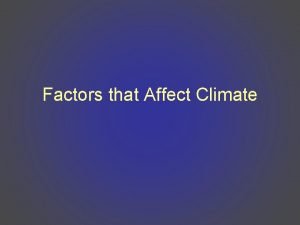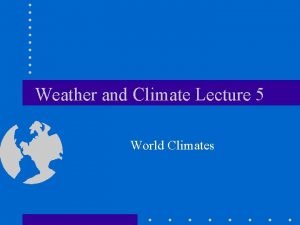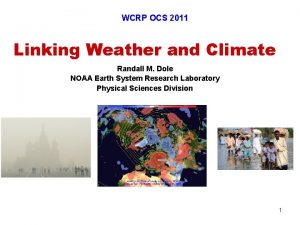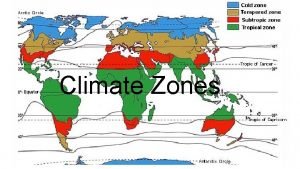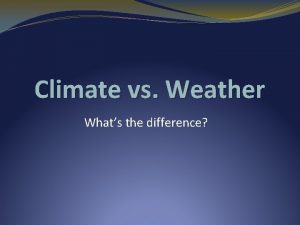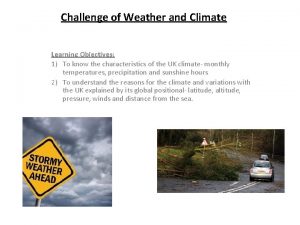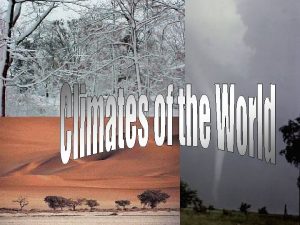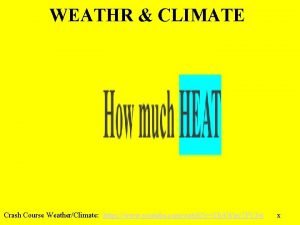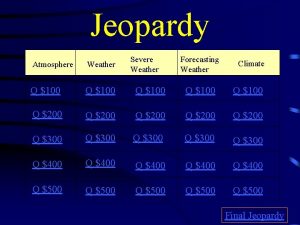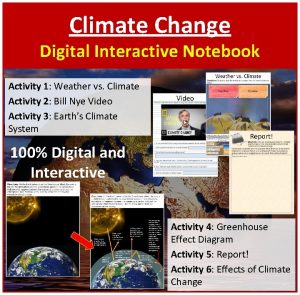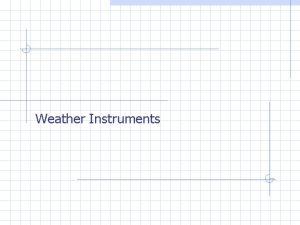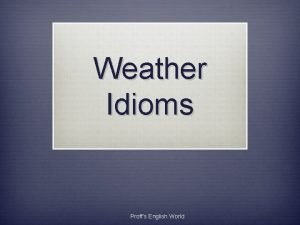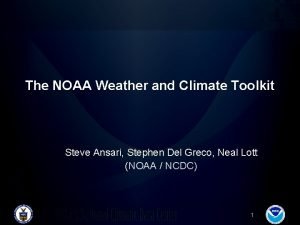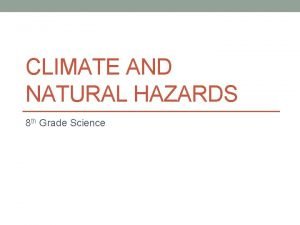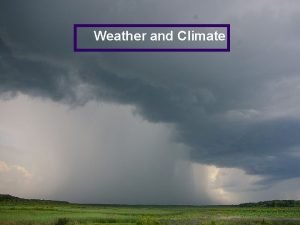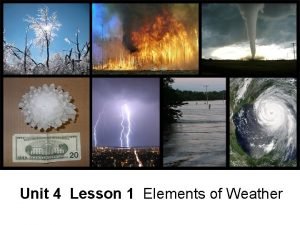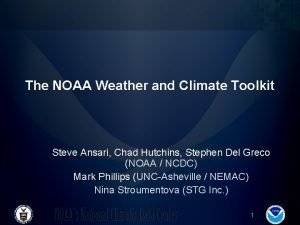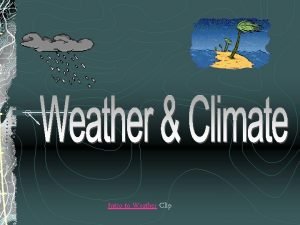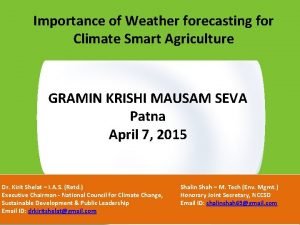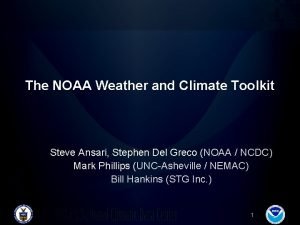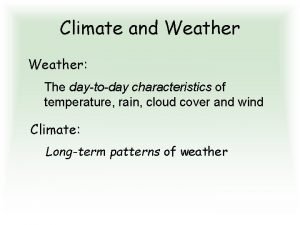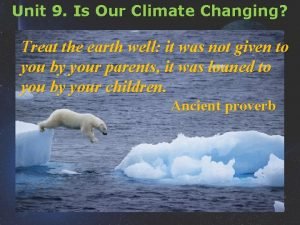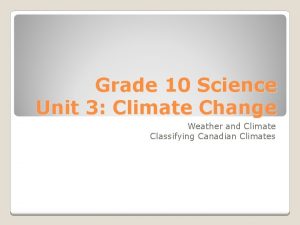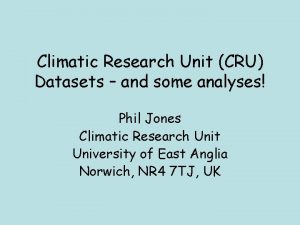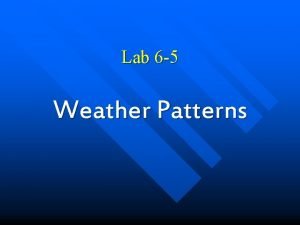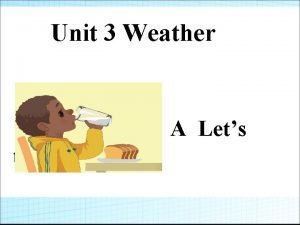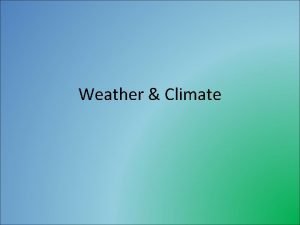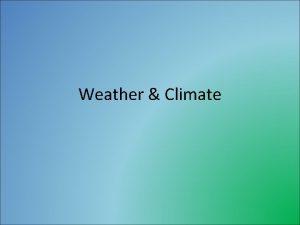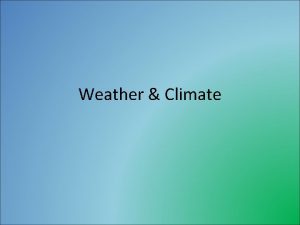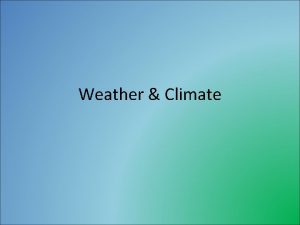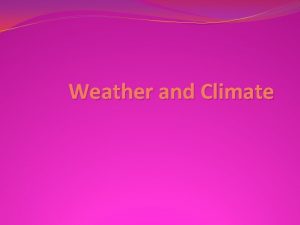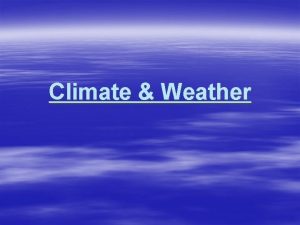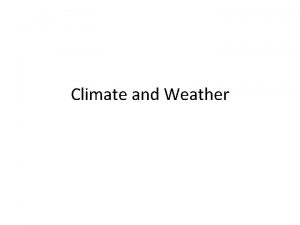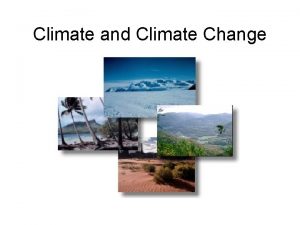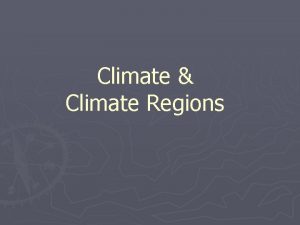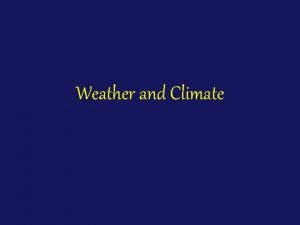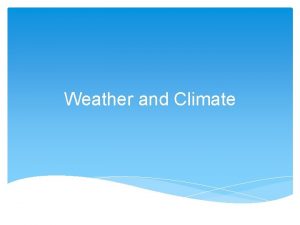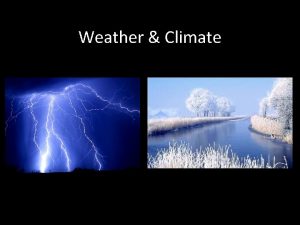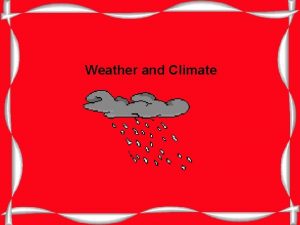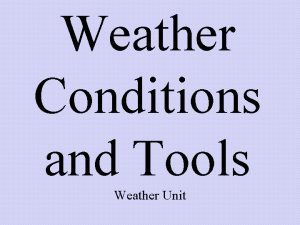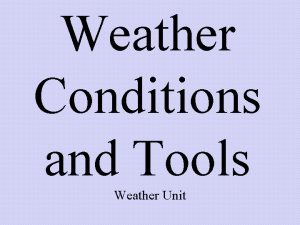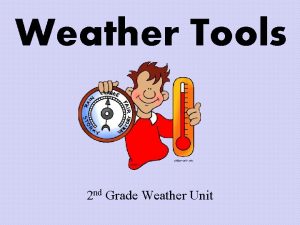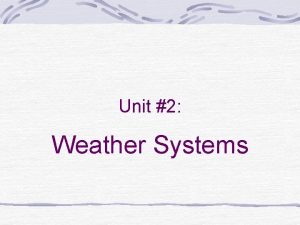UNIT 3 3 Climate Weather Weather vs Climate








































- Slides: 40


UNIT 3. 3

Climate & Weather

Weather vs. Climate • Weather is constantly changing, and it refers to the state of the atmosphere at any given time and place. • Climate, however, is based on observations of weather that have been collected over many years. Climate helps describe a place or region.

Major Components of Air • Air is a mixture of different gases and particles, each with its own physical properties.

Composition of the Atmosphere • Water vapor is the source of all clouds and precipitation. Like carbon dioxide, water vapor absorbs heat given off by Earth. It also absorbs some solar energy. • Ozone is a form of oxygen that combines three oxygen atoms into each molecule (O 3). • If ozone did not filter most UV radiation and all of the sun’s UV rays reached the surface of Earth, our planet would be uninhabitable for many living organisms.

Human Influence • We also add to the atmosphere


Atmosphere • At different levels, there are different characteristics that are noticed. • The higher you go, the thinner the atmosphere gets until there is too few gas molecules to detect. • Pressure also changes as you travel up!

Height & Structure Changes • Atmosphere can be divided into four layers

Troposphere � Troposphere - bottom layer of the atmosphere where temperature decreases with an increase in altitude.

stratosphere � Stratosphere - layer of the atmosphere where temperature remains constant to a height of about 20 kilometers. It then begins a gradual increase until the stratopause.

mesosphere � Mesosphere - layer of the atmosphere immediately above the stratosphere and is characterized by decreasing temperatures with height.

thermosphere • Thermosphere - region of the atmosphere immediately above the mesosphere and is characterized by increasing temperatures due to the absorption of very short-wave solar energy by oxygen.

Atmosphere assignment


Earth – Sun Relationship • Movements of Earth can defined in two ways • Rotation • Revolution • Seasonal changes occur because Earth’s position relative to the sun continually changes as it travels along its orbit.

Solstices & Equinox

Heat and the Atmosphere • Heat is the energy transferred from one object to another because of a difference in the objects’ temperature. • Temperature is a measure of the average kinetic energy of the individual atoms or molecules in a substance. • Energy is transferred three ways • Conduction • Convection • Radiation

Conduction is the transfer of heat through matter by molecular activity Convection is the transfer of heat by mass movement or circulation within a substance Radiation is the transfer of energy (heat) through space by electromagnetic waves that travel out in all directions.



Why temperatures vary • • • Land heats more rapidly and to higher temperatures than water. Land also cools more rapidly and to lower temperatures than water. The geographic setting can greatly influence temperatures experienced at a specific location The altitude can greatly influence temperatures experienced at a specific location. Albedo is the fraction of total radiation that is reflected by any surface. Many clouds have a high albedo and therefore reflect back to space a significant portion of the sunlight that strikes them.


Water in the Atmosphere • • When it comes to understanding atmospheric processes, water vapor is the most important gas in the atmosphere. Precipitation – any form of water that falls from clouds

Changing States

Humidity • Humidity is a general term for the amount of water vapor in air. • Relative humidity is a ratio of the air’s actual water-vapor content compared with the amount of water vapor air can hold at that temperature and pressure. • Dew point is the temperature to which a parcel of air would need to be cooled to reach saturation.

Measuring Humidity • A hygrometer is an instrument to measure relative humidity. • A psychrometer is a hygrometer with dry- and wet-bulb thermometers. Evaporation of water from the wet bulb makes air temperature appear lower than the dry bulb’s measurement. The two temperatures are compared to determine the relative humidity.

Clouds

Your assignment • Look up how clouds are formed!

Types of Clouds • • • Clouds are classified on the basis of their form and height Cirrus (cirrus = curl of hair) are clouds that are high, white, and thin. Cumulus (cumulus = a pile) are clouds that consist of rounded individual cloud masses. Stratus (stratus = a layer) are clouds best described as sheets or layers that cover much or all of the sky. There are HIGH, MID, and LOW clouds.

• High Clouds • Cirrus clouds are high, white, and thin. • Cirrostratus clouds are flat layers of clouds. • Cirrocumulus clouds consist of fluffy masses.

• Mid Clouds • Altocumulus clouds are composed of rounded masses that differ from cirrocumulus clouds in that they are larger and denser. • Altostratus clouds create a uniform white to gray sheet covering the sky with the sun or moon visible as a bright spot.

• Low Clouds • Stratus clouds are best described as sheets or layers that cover much or all of the sky. • Stratocumulus clouds have a scalloped bottom that appears as long parallel rolls or broken rounded patches. • Nimbostratus clouds are the main precipitation makers.

Then there is FOG • Fog is simply defined as a cloud that forms at or near the ground.

Air Pressure Air pressure is the pressure exerted by the weight of air. Air pressure is exerted in all directions— down, up, and sideways. The air pressure pushing down on an object exactly balances the air pressure pushing up on the object. To measure air pressure we use a barometer.

Wind • Wind is the result of horizontal differences in air pressure. Air flows from areas of higher pressure to areas of lower pressure. • The unequal heating of Earth’s surface generates pressure differences. Solar radiation is the ultimate energy source for most wind. • Three factors combine to control wind: pressure differences, the Coriolis effect, and friction. •

• • Factors that also make wind – PRESSURE • A pressure gradient is the amount of pressure change occurring over a given distance. • Closely spaced isobars—lines on a map that connect places of equal air pressure—indicate a steep pressure gradient and high winds. Widely spaced isobars indicate a weak pressure gradient and light winds.

Coriolis Effect • The Coriolis effect describes how Earth’s rotation affects moving objects. In the Northern Hemisphere, all free-moving objects or fluids, including the wind, are deflected to the right of their path of motion. In the Southern Hemisphere, they are deflected to the left.

Wind patterns
 Climate change 2014 mitigation of climate change
Climate change 2014 mitigation of climate change Unit 10, unit 10 review tests, unit 10 general test
Unit 10, unit 10 review tests, unit 10 general test World geography today
World geography today Clim 101
Clim 101 How does wind affect weather and climate
How does wind affect weather and climate Weather and climate similarities
Weather and climate similarities Conclusion of weather and climate
Conclusion of weather and climate Climate zones and weather worksheet answer key
Climate zones and weather worksheet answer key Whats the difference between weather and climate
Whats the difference between weather and climate Objectives of weather and climate
Objectives of weather and climate Factors affecting climate
Factors affecting climate Weathr today
Weathr today Temperate zone latitude
Temperate zone latitude What causes warm air to rise brainpop
What causes warm air to rise brainpop Weather and climate jeopardy
Weather and climate jeopardy Weather and climate interactive activities
Weather and climate interactive activities Tools to measure weather
Tools to measure weather Cloud nine idiom
Cloud nine idiom Poem of seasons
Poem of seasons Noaa toolkit
Noaa toolkit Bill nye weather and climate worksheet
Bill nye weather and climate worksheet Climatell
Climatell Kahoot quiz
Kahoot quiz Elements of weather lesson plan
Elements of weather lesson plan Noaa climate toolkit
Noaa climate toolkit Brainpop1
Brainpop1 Contingent crop planning slideshare
Contingent crop planning slideshare Venn diagram of reflection and refraction
Venn diagram of reflection and refraction Noaa weather and climate toolkit
Noaa weather and climate toolkit What is the red line on a climate graph
What is the red line on a climate graph Station model weather symbols
Station model weather symbols Tongue twister about weather
Tongue twister about weather Windy
Windy Weather vs whether
Weather vs whether Heavy weather by weather report
Heavy weather by weather report Capital weather gang weather wall
Capital weather gang weather wall Unit 9 climate change
Unit 9 climate change Unit 3 climate
Unit 3 climate Cru climate research unit
Cru climate research unit Lab 6-5 weather patterns
Lab 6-5 weather patterns Unit 3 weather
Unit 3 weather



